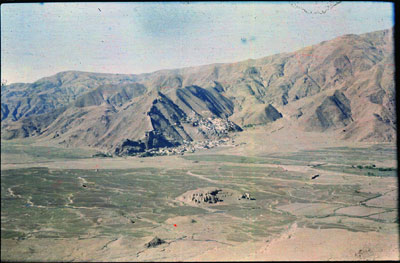
BMR.6.8.83 (Transparency colour)


BMR.6.8.83 (Transparency colour)

Hugh E. Richardson
Hugh Richardson
1936-50
Chyongye Valley Region > Chyongye
BMR.6.8.83
60 x 90 mm
Transparency Colour
Richardson's 1949 tour of the Yarlung and Chyongye valleys
Technical Information - The camera used to take this collection of colour slides (Dufay colour) were a Zeiss Super Ikonta and a Reflex Korelle. [KC 09/10/2006]
Manual Catalogues - Typewritten handlist entitled 'Hugh Richardson Collection, The British Museum. Photographs taken between 1936-50. Cameras: Zeiss Super Ikonta, Reflex Korelle. 300 colour slides (Dufay colour); copies made Jan. 1995.
[no.] 83. Burial mound (bangso) of Tride Songtsen (Khri de Tsong tsen) at Chonggye. The town and monastery of Chonggye are in the background. Photo from Ralpachen's tomb.' [KC 10/10/2006]
Other Information - Location: Richardson wrote an article about the location and the historical significance of the early burial grounds in the Chyonggye valley near Yarlung in Central asiatic Journal , 8,2 (1963), pp. 73-92 reproduced in High Peaks, Pure Earth , London, Serindia Publications, 1998, pp. 219-233. "'Phyong-rgyas is some sixty-five miles south-east of Lhasa, near the head of a tributary of the Yar-lung Chu which flows south into the Gtsang-po near Rtse-thang. There, in brooding and majestic solitude, rise the burial mounds of the kings ... . Not far away to the north, at the foot of the hills which enclose the valley, is the village of 'Phyong-rgyas dominated by its rdzong ; and on a sheltered hillside above the village there is the Dge-lugs-pa monastery of Ri-bo bde-chen. Higher up the steep ridge on which the rdzong stands are the ruins of what is traditionally identified with Phying-ba'i Stag-rtse, the ancient stronghold of the Tibetan kings." (219-220) Also, "About twelve miles up the ['Phyong-rgyas] valley and visible from a considerable distance are the brooding forms of the great burial tumuli ( bang-so ) (1949) of the Tibetan kings." (320) "The photographs show that some of the surviving mounds are larger than others. The smaller mounds are those attributed to Ljang-tsha Lhas-bon, Mu-rug and Mu-ne Btsan-po. Neither of the first two was enthroned as king ... [and the last] may not have been enthroned as king." (225) [KC 17/10/2006]
For Citation use:
The Tibet Album.
"Settlement of Chyongye with burial mounds "
05 Dec. 2006. The British Museum.
<http://tibet.prm.ox.ac.uk/photo_BMR.6.8.83.html>.
For more information about photographic usage or to order prints, please visit the The British Museum.
© The British Museum